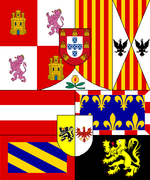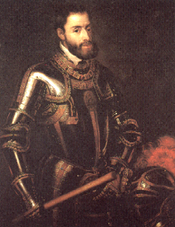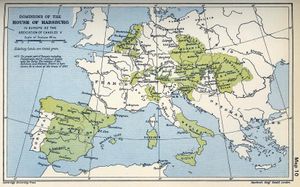Charles V, Holy Roman Emperor
2007 Schools Wikipedia Selection. Related subjects: Historical figures
|
||||||||||||||||||||||||||||||
Charles V ( 24 February 1500 – 21 September 1558) was ruler of the Burgundian territories ( 1506- 1555), King of Castile ( 1516- 1556), King of Aragon (1516-1556), King of Naples and Sicily (1516- 1554), Archduke of Austria ( 1519- 1521), King of the Romans (or German King), (1519- 1531) and Holy Roman Emperor (1530-1556). In Spain, though he is often referred to as Carlos V, he ruled officially as Carlos I, hence Charles I of Spain. He is also known in English by his French name, Charles Quint.
He was the son of Philip the Handsome and Joanna the Mad of Castile. His maternal grandparents were Ferdinand II of Aragon and Isabella I of Castile, whose marriage had first united Spain. His paternal grandparents were Emperor Maximilian I and Mary of Burgundy. His aunt was Catherine of Aragon, Queen of England and first wife of Henry VIII, his cousin was Mary I of England who married his son Philip.
Charles V's reign introduced the first documented use of the styles of His Majesty or His Imperial Majesty. Because of his far-reaching territories he was described as ruling an Empire " in which the sun does not set".
Heritage and early life
Combining in himself the heritage of the German Habsburgs, the House of Burgundy, and the Spanish heritage of his mother, Charles transcended ethnic and national boundaries.
Charles was born in the Flemish city of Ghent and brought up in Mechelen by his aunt Margaret until 1517. The culture and courtly life of the Burgundian Low Countries was the prime influence in his early life. He was brought up to speak French and Flemish, but also added Spanish and some German . Indeed, he was said to speak "Spanish to God, Italian to women, French to men, and German to his horse". He could not speak Spanish very well, as it was not his primary language.
From his Burgundian ancestors, he inherited an ambiguous relationship with the Kings of France. Charles shared with France his mother tongue and many cultural forms. In his youth, he made frequent visits to Paris, then the largest city of Western Europe, which he thoroughly enjoyed. In his words: "Paris is not a city, but a universe" ( Lutetia non urbs, sed orbis). But Charles was also born into the tradition of political and dynastical enmity between the Royal and the Burgundian lines of the Valois Dynasty.
This conflict was amplified by his accession to both the Holy Roman Empire and the kingdom of Spain. Though Spain was the core of his kingdom, he was never totally assimilated and especially in his earlier years felt and was viewed as a foreign prince. Nonetheless, he spent most of his life in Spain, including his final years in a Spanish monastery.
In his youth, Charles was tutored by Adrian of Utrecht, later Pope Adrian VI. His three most prominent subsequent advisors were Lord Chièvres, Jean Sauvage and Mercurino Gattinara.
Marriage and children
On March 10, 1526, Charles married his first cousin Isabella of Portugal, sister of John III of Portugal.
Their children included:
- Philip II of Spain ( 1527 - 1598), the only son to reach adulthood.
- Maria of Spain ( 1528 - 1603), who married her cousin Maximilian II, Holy Roman Emperor.
- Joan of Habsburg ( 1537 - 1573)
Charles is also infamous for his many mistresses. Two of them gave birth to two future Governors of the Habsburg Netherlands:
- Johanna Maria van der Gheynst bore Margaret of Parma and
- Barbara Blomberg bore John of Austria.
Reign
Burgundy and the Low Countries
In 1506, Charles inherited his father's Burgundian territories, most notably the Low Countries and Franche-Comté, although, as he was a minor, his aunt Margaret acted as regent until 1515.
Charles extended the Burgundian territory with the annexation of Tournai, Artois, Utrecht, Groningen and Guelders. The Seventeen Provinces had been unified by Charles' Burgundian ancestors, but nominally were fiefs of either France or the Holy Roman Empire. In 1549, Charles issued a Pragmatic Sanction, declaring the Low Countries as a unified entity of which his family would be the heirs..
The Low Countries held an important place in the Empire. For Charles personally, they were the region where he spent his childhood. Because of trade and industry and the rich cities, they were also important for the treasury.
Spain
With the death of his grand-father Ferdinand II, on May 30, 1516 Charles became the first king of a united Spain. Charles inherited his grandfather's realm, which included Aragon, Navarre, Naples, Sicily and Sardinia, and also became joint-king of Castile and guardian of his insane mother Joanna. With the Castilian crown he also gained Granada and the Spanish possessions in the New World.
For the first time the crowns of Castile and Aragon were united in one person. Ferdinand and Isabella had each been sovereign in one kingdom, but only consort in the other.
Charles arrived in his new kingdoms in autumn of 1517. His regent Jiménez de Cisneros came to meet him, but fell ill along the way, not without a suspicion of poison. Charles sent him a letter to thank him for his services, but Cisneros died before meeting the King.
Negotiations with the Castilian Cortes proved difficult, and in the end Charles was accepted under the following conditions: he would learn to speak Castilian; he would not appoint foreigners; he was prohibited from taking precious metals from Castile; and he would respect the rights of his mother, Queen Joanna. The Cortes paid homage to him in Valladolid in 1518. In 1519 he was crowned before the Cortes of Aragon in Zaragoza, and the Cortes of Catalonia followed.
Charles was accepted as sovereign, even though the Spanish felt uneasy with the Imperial style; Spanish monarchs until then had been bound by the laws, the monarchy was a contract with the people. With Charles it would become more absolute, even though until his mother's death in 1555 Charles did not hold the full kingship of the country.
Soon resistance against the Emperor rose, because of the heavy taxation – funds that were used to fight wars abroad, wars most Castilians had no interest in – and because Charles tended to select Flemings for high offices in Spain and America, ignoring Castilian candidates. The resistance culminated in the Castilian War of the Communities, which was suppressed by Charles. After this, Castile became integrated into the Habsburgs' empire, and would provide the bulk of the Habsburg's military and financial resources.
America
During Charles' reign, the territories in New Spain were considerably extended by conquistadores like Hernán Cortés and Francisco Pizarro, who brought the Aztec and Inca empires to fall in little more than a decade. Combined with the circumnavigation of the globe in 1522, this gave to Charles a strong impression of his divine mission to become the leader of a christian world. The conquests also provided the state treasury with enormous amounts of bullion. The conquistador Bernal Diaz had already observed: "We came to serve God and our Majesty, ... and also to get rich." In 1550, Charles convened a conference at Valladolid in order to consider the morality of the force used against the indigenous populations of Spanish America.
Holy Roman Empire
After the death of his other grandfather, Maximilian, in 1519, he inherited Habsburg lands in Austria. Naturally, he also was the candidate for succeeding Maximilian as Emperor, but he had to face the competition of the French King Francis I, who also had the support of Pope Leo X. Francis used promises and bribes to win the favour of the electors, but with the help of the wealthy Fugger family Charles could oust Francis and was elected on June 28, 1519. In 1530 he was crowned Holy Roman Emperor by Pope Clement VII in Bologna, the last Emperor to receive a papal coronation.
Charles was Holy Roman Emperor over the German states, but his real power was limited by the princes. Protestantism gained a lot of support in Germany, and Charles was determined not to let this happen in the Netherlands. An inquisition was established as early as 1522. In 1550 the death penalty was introduced for all heresy. Political dissent was also firmly controlled, most notably in his place of birth: the Revolt of Ghent in 1539, which Charles personally suppressed.
Wars against France
Much of Charles's reign was taken up with wars with France, which found itself encircled by Charles's empire and still maintained ambitions in Italy. The first war with Charles's great nemesis Francis I of France began in 1521. Charles allied with England and Pope Leo X against the French and the Venetians, and was highly successful, driving the French out of Milan and defeating and capturing Francis at the Battle of Pavia in 1525, and forcing him to sign the humiliating Treaty of Madrid the next year, in which the French king was forced to cede Burgundy to Charles.
When he was released, however, Francis had the parlement de Paris denounce the treaty because it had been signed under duress. Already the Pope had formed the League of Cognac with Henry VIII of England, the Venetians, the Florentines, and the Milanese to resist imperial domination of Italy, and Francis soon joined. This war was notable for the sack of Rome by Charles's forces in 1527, which took the Pope out of the war. Charles's occupation of Rome and virtual imprisonment of Pope Clement VII allowed him to keep the Pope from annulling the marriage of Henry VIII of England and Charles's aunt Catherine of Aragon, with important consequences. Besides the sack, the war itself was inconclusive, and came to an end with the compromise Treaty of Cambrai in 1529, called the "Ladies' Peace" because it was negotiated between Charles's aunt and Francis's mother, in which Francis renounced his claims in Italy but retained control of Burgundy.
A third war erupted in 1535, when, following the death of the last Sforza Duke of Milan, Charles installed his own son, Philip in the duchy, despite Francis's claims on it. The war was inconclusive. Francis failed to conquer Milan, but was successful in conquering most of the lands of Charles's ally the Duke of Savoy, including his capital, Turin. A truce at Nice in 1538 on the basis of uti possidetis ended the war, but only for a short time. The Italian war of 1542 resumed in 1542, with Francis now actively allied with Ottoman Sultan Suleiman I, and Charles once again allied with Henry VIII. Despite the conquest of Nice by a Franco-Ottoman fleet, the French remained unable to advance into Milan, while a joint Anglo-Imperial invasion of northern France, led by Charles himself, won some successes but was ultimately abandoned, leading to another peace and restoration of the status quo ante in 1544.
A final war erupted with Francis's son and successor, Henry II, in 1551. This war saw early successes by Henry in Lorraine, where he captured Metz, but continued failure of French offensives in Italy. Charles abdicated midway through this conflict, leaving further conduct of the war to his son, Philip II and his brother, Ferdinand I, Holy Roman Emperor.
Wars against the Ottoman Empire
Charles had been fighting with the Ottoman Empire and its sultan, Suleiman the Magnificent, for a number of years. The expeditions of the Ottoman force along the Mediterranean coast posed a threat to Habsburg lands and the peace of Western Europe. In Central Europe, the Turkish advance was halted at Vienna in 1529, which they besieged unsuccessfully. In 1535 Charles won an important victory at Tunis, but in 1536 Francis I of France allied himself with Suleiman against Charles. While Francis was persuaded to sign a peace treaty in 1538, he again allied himself with the Ottomans in 1542. In 1543 Charles allied himself with Henry VIII and forced Francis to sign the Truce of Crepy-en-Laonnois. Charles later signed a humiliating treaty with the Ottomans, to gain him some respite from the huge expenses of their war, although it wasn't over. However, the Protestant powers in the Holy Roman Empire Diet often voted against money for his Turkish wars, as many Protestants saw the Muslim advance as a counterweight to the Catholic powers. The great Hungarian defeat at the 1526 Battle of Mohacs was in some ways a moral defeat for the West as a whole.
Humanism and Reformation
As Holy Roman Emperor, he called Martin Luther to the Diet of Worms in 1521, promising him safe conduct if he would appear. He initially dismissed Luther's idea of reformation as, "An argument between monks". He later outlawed Luther and his followers in that same year but was tied up with other concerns and unable to try to stamp out Protestantism.
1524 to 1526 saw the Peasants' Revolt in Germany and the formation of the Lutheran Schmalkaldic League, and Charles delegated increasing responsibility for Germany to his brother Ferdinand while he concentrated on problems abroad.
In 1545 the opening of the Council of Trent began the Counter-Reformation, and Charles won to the Catholic cause some of the princes of the Holy Roman Empire. He also attacked the Schmalkaldic League in 1546 and at the Battle of Mühlberg defeated John Frederick, Elector of Saxony and imprisoned Philip of Hesse in 1547. At the Augsburg Interim in 1548 he created a doctrinal compromise that he felt Catholics and Protestants alike might share. A more permanent settlement followed with the 1555 Peace of Augsburg.
Abdication and later life
 |
Wikimedia Commons has media related to: Charles V, Holy Roman Emperor
|
In 1556 Charles abdicated his various titles, giving his personal empire to his son, Philip II of Spain, and the Holy Empire to his brother, Ferdinand. Charles retired to the monastery of Yuste in Extremadura, but continued to correspond widely and kept an interest in the situation of the empire. He suffered from severe gout and some scholars think Charles V decided to abdicate after a gout attack in 1552 forced him to postpone an attempt to recapture the French city of Metz, where he was later defeated..
Charles died on September 21, 1558. Twenty-six years later his remains were transferred to the Royal Pantheon of The Monastery of San Lorenzo de El Escorial.
Trivia
- He suffered from an enlarged lower jaw, a deformity which got considerably worse in later Habsburg generations.
- He struggled to chew his food properly and consequently experienced bad indigestion for much of his life.
- As a result he usually ate alone.
- He was afraid of mice and spiders.
- He was obsessed with clocks and instructed his servants to take them apart and reassemble them in his presence.
- In his retirement, he was carried around the monastery of St. Yuste in a sedan chair.
- A ramp was specially constructed to allow him easy access to his rooms.
- He passed his time fishing from his window on the first floor and enjoying the smell of incense drifting on the breeze from the abbey church.
Ancestors
| Charles V, Holy Roman Emperor | Father: Philip I of Castile |
Paternal Grandfather: Maximilian I, Holy Roman Emperor |
Paternal Great-Grandfather: Frederick III, Holy Roman Emperor |
| Paternal Great-Grandmother: Eleanor of Portugal, Empress |
|||
| Paternal Grandmother: Mary of Burgundy |
Paternal Great-Grandfather: Charles the Bold |
||
| Paternal Great-Grandmother: Isabella of Bourbon |
|||
| Mother: Joanna of Castile |
Maternal Grandfather: Ferdinand II of Aragon |
Maternal Great-Grandfather: John II of Aragon |
|
| Maternal Great-Grandmother: Juana Enriquez |
|||
| Maternal Grandmother: Isabella I of Castile |
Maternal Great-Grandfather: John II of Castile |
||
| Maternal Great-Grandmother: Infanta Isabel of Portugal |






